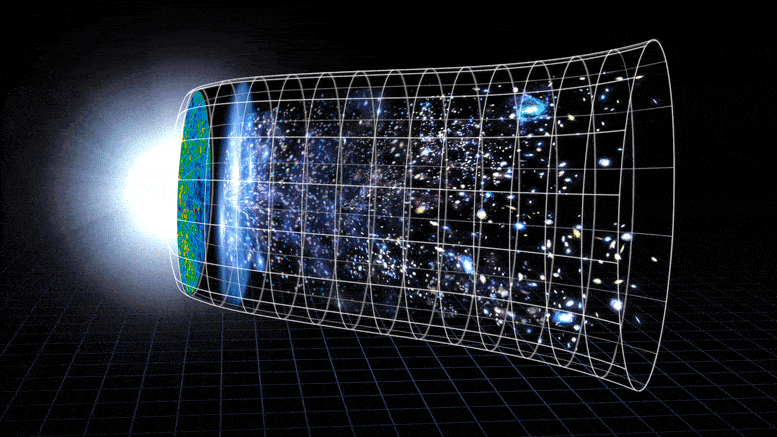Cosmological calculations almost always assume that there is a uniform distribution of matter in the universe. This is because the calculations would be too complicated if they included the location of each and every star. In reality the universe is not uniform: there are places with stars and planets, and in other places there is only empty space. Now researchers are trying to understand how this is accounted for

Scientists study the expansion of the universe using methods from many-body physics.
Cosmological calculations almost always assume that there is a uniform distribution of matter in the universe. This is because the calculations would be too complicated if they included the location of each and every star. In reality the universe is not uniform: there are places with stars and planets, and in other places there is only empty space.
Physicists Michael Te Frucht and Prof. Raphael Witkowski from the Institute for Theoretical Physics and the Center for Soft Nanotechnology (nanotechnology that refers to organic or organometallic materials) at the University of Münster have developed, together with physicist Dr. Sabina Hossenfelder from the Frankfurt Institute of Advanced Sciences, a new model for the problem . Their starting point was the Murray-Zwanzig formalism, a method for describing systems consisting of a large number of particles using a small number of measurable quantities. The results of the study have now been published in the journal Physical Review Letters.
Background: The theory of general relativity developed by Albert Einstein is one of the most successful theories in modern physics. Two of the last five Nobel Prizes in physics are related to her: in 2017 for the measurement of gravitational waves, and in 2020 for the discovery of a black hole at the center of the Milky Way. One of the most important applications of the theory is in the description of the expansion of the universe since the big bang. The speed of this expansion is determined by the amount of energy in the universe. In addition to visible matter, dark matter and dark energy are the ones that above all play a role here - at least according to the meta-CDM model currently used in cosmology.
"In the narrow sense of things, it is mathematically wrong to include the average value of the energy density of the universe in the equations of general relativity," says Sabina Hossenfelder. The question now is how "serious" is this error. Some experts believe that it is not relevant, others see it as the solution to the mystery of dark matter, the physical nature of which is still unknown. It is possible that the uneven distribution of mass in the universe has an effect on the speed of expansion of the universe.
"The Mori-Zwanzig formalism is already used successfully in many research fields, from biophysics to particle physics," says Raphael Witkowski, "therefore it offered a promising approach to this astrophysical problem." The team generalized this formalism so that it can be applied to general relativity, and in doing so created a model for the expansion of the universe that takes into account the non-uniform distribution of matter in the universe.
The model robustly predicts the effect of this inhomogeneity on the expansion rate of the universe. This prediction deviates somewhat from the prediction given by the meta-CDM model and thus allows an opportunity to test this new model experimentally. "Currently, the astronomical data is not accurate enough to measure this deviation", says Michael Te Frucht, "but the great progress that has been achieved - for example, in the measurement of gravitational waves - gives us hope that this will change. And in addition, the new version of the Mori-Zwanzig formalism can also be applied to other astrophysical problems - so the work is not only relevant to cosmology."
More of the topic in Hayadan:
- The universe does not expand uniformly
- Measuring the Universe's Expansion: Surprising Discrepancies Hint at Inconsistencies in the Universe's Composition
- Dark energy: a map hints at what it is - but deepens the dispute over the expansion rate of the universe
- The rate of expansion of the universe is controversial - and we may need new physics to quantify itWill gravitational waves be able to shed light on the expansion rate of the universe?

3 תגובות
Philosophically, the changing size of the universe over time is a paradox. After all, how does the size (space) of a universe change in time, which is defined as the entire space-time. If he is everything, which means he is of infinite size, then even when he was "small" he was of infinite size (and therefore cannot be "small"). And if he is also time (space-time) then how did he start before there was even time.
The only logical explanation is that outside the universe there is "space", and there is "time", and the universe is not all space and time. but a part of a space of time that spreads within a larger space of time.
Asher Greenberg
The question is what is the source of the coincidence...
The universe is homogeneous on a large scale. There are spaces between the substance concentrations. This has been known for 100 years. The quantum randomness "determines" which concentration is greater and which is less than it. the contingencies. What is there to explore here? Would you investigate every bubble in the mixture you cook in the kitchen? What is unclear here?